12 Cooking Fire Statistics & Safety Tips (2024)
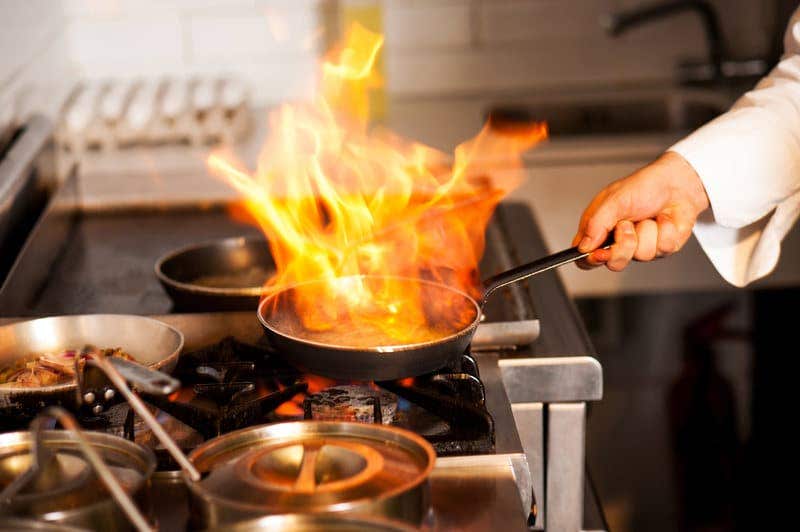
I have extracted the most compelling statistics and facts from a number of comprehensive reports on cooking fires from 1980 to 2018, but most of the findings highlight data from 2014 to 2018. Unless otherwise specified, our post refers to data collected from 2014 to 2018.
Here are 12 of the most interesting trends and compelling cooking fire statistics:
- Cooking causes nearly half (49%) of all home structure fires in the US.
- 80% of cooktops involved in cooking fires are electric.
- About 2.5x more fires occur in households with electric ranges compared to gas ranges.
- Fires due to electric ranges result in nearly 5x more injuries compared to gas ranges.
- Fires due to electric ranges cause nearly 4x more property damage (USD) than gas ranges.
- Since 2012, cooking fires have increased by more than 31%.
- Since 2012, property damage resulting from these fires has increased by more than 30%.
- The leading cause of cooking fires is unattended cooking equipment (31%).
- Cooking oil, lard, grease, and other combustibles are involved in over half of home cooking fires.
- In 2018, Thanksgiving reported the most fires in one day, followed by Christmas, the day before Thanksgiving, Easter, and Christmas Eve.
- Being asleep accounts for 23% of late-night cooking fires.
- Nineteen percent of injuries are due to cooking fires are people aged 25-34, larger than any other age group.
**firefighter injuries and deaths are excluded from these numbers.
According to the stats, cooking fires cause numerous injuries, fatalities, and property damage each year. The good news is that many of these fires are preventable with some basic knowledge of fire safety and by taking necessary precautions while cooking. In this article, we will examine some of the most compelling statistics and facts about cooking fires, and provide you with essential safety tips to prevent a fire from starting in your kitchen.
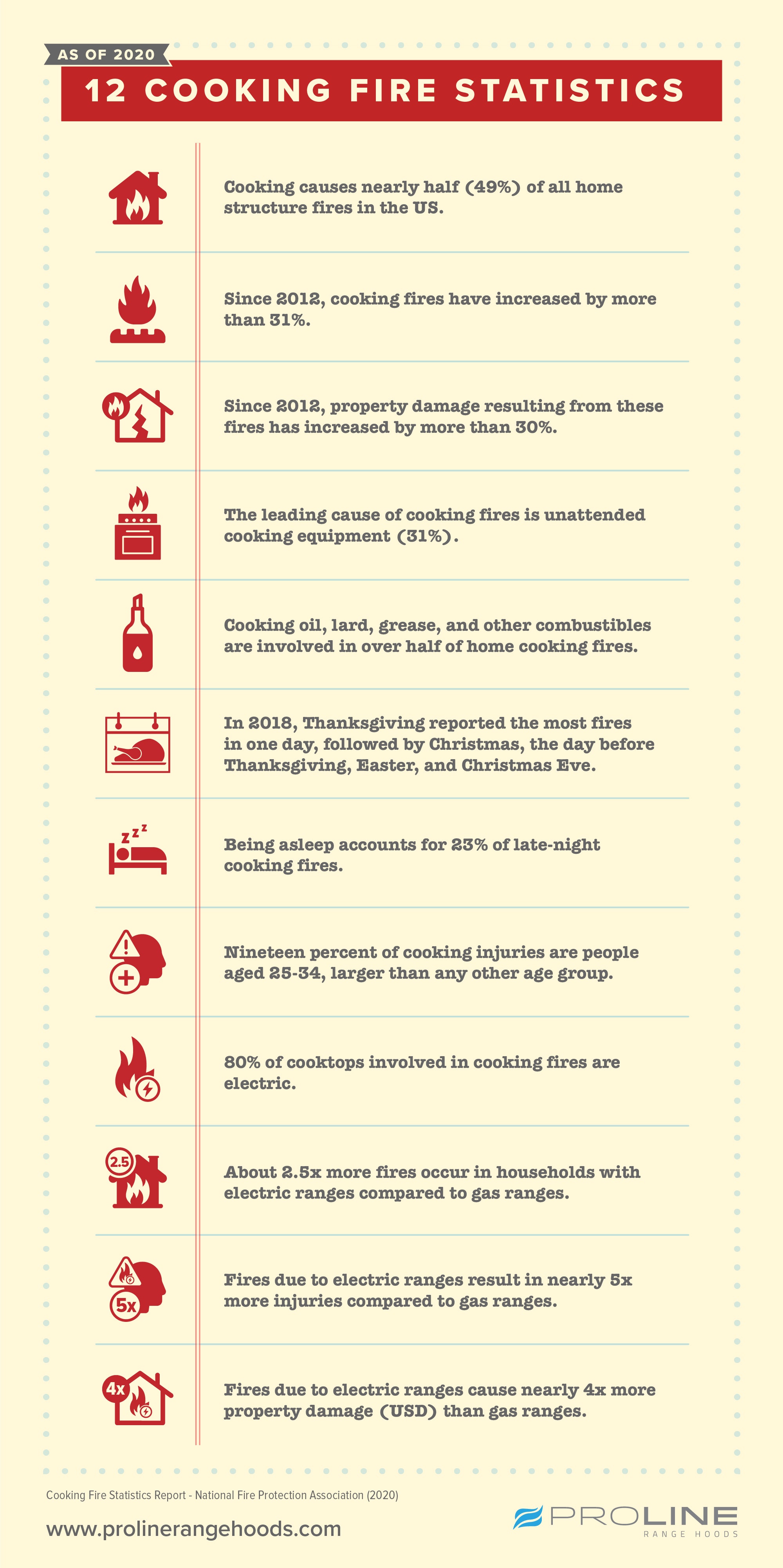
Table of Contents
Cooking Fire Statistics
Cooking causes nearly half (49%) of all home structure fires in the US.
Cooking fires lead to an average of 550 deaths and 4,820 injuries every year. That’s right, cooking can be a matter of life and death. The 550 deaths make up 21% of all reported home fire deaths, while the injuries make up nearly half (44%) of all reported home fire injuries. That’s a staggering number of people who are affected by cooking fires each year.
Most cooking fires are small and can be easily extinguished with a fire extinguisher or a damp towel. But if people aren’t equipped to handle them, they can get out of control quickly. That’s why it’s important to take precautions when cooking. Homeowners should make sure they have a fire extinguisher close by and know how to use it in case of emergency. It’s better to be prepared than to regret it later.
Since 2012, cooking fires have increased by more than 31%.
From 1980 to 2011, the average annual number of cooking fires in the US was 131,300. That’s a lot of fires, but it gets even worse. From 2012 to 2018, that number increased to 172,500. That’s an alarming 31% increase in just a few short years.
Despite continued research and efforts to promote cooking safety and fire safety, the number of cooking fires in the US continues to rise. This could be due to a number of factors, primarily population growth. With more people cooking at home, the likelihood of fires increases. But this data is beyond the scope of this article.
It’s important to note that cooking fires are preventable. By taking simple precautions such as never leaving cooking unattended and keeping flammable materials away from heat sources, we can reduce the risk of fires. Homeowners should also ensure that their cooking appliances are well-maintained and in good working order.
Since 2012, property damage resulting from these fires has increased by more than 30%.
Fires in the US caused an average of $958 million in property damage annually from 1980 to 2011. That’s a staggering figure, but unfortunately, it gets even worse. From 2012 to 2018, that average increased to $1,248 million per year.
The increase in property damage caused by fires is a concerning trend. As our population continues to grow and we increasingly live in denser urban areas, the risk of widespread property damage in the event of a fire is much higher than it was in the late 1900s.
This highlights the importance of taking fire safety seriously, not only for our own safety but for the safety of those around us.
While it’s true that not all fires can be prevented, there are steps we can take to minimize the risk. This includes making sure that our homes are equipped with smoke alarms, having a fire evacuation plan, and ensuring that all heating and cooking equipment is well-maintained and used correctly.
The leading cause of cooking fires is unattended cooking equipment (31%).
Unattended cooking equipment is the leading cause of cooking fires in the US by a wide margin. In fact, it accounts for a staggering 31% of all cooking fires. That’s more than double the next leading cause, which is abandoned or discarded material (10%).
This can include leaving flammable materials in a trash bin or leaving cookware unattended, which could quickly lead to a dangerous fire.
These statistics are a sobering reminder of the importance of being vigilant while cooking. It only takes a moment of distraction to turn a harmless cooking activity into a catastrophic disaster.
A kitchen fire not only endangers the occupants of a home but also neighbors and firefighters who respond to the emergency.
To reduce the risk of kitchen fires, homeowners should always keep an eye on their food while cooking and never leave cooking equipment unattended. They should also ensure that all flammable materials, such as dish towels, oven mitts, and paper products, are kept away from the stovetop.
Cooking oil, lard, grease, and other combustibles are involved in over half of home cooking fires.
It’s important to note that the statistics on cooking fires don’t include fires resulting from utensils and materials that don’t generate heat, such as can openers, measuring cups, and spatulas. While these may seem like harmless kitchen tools, they can still pose a fire hazard if not used properly or stored correctly.
When it comes to cooking with oil, shortening, or other fats, it’s crucial to be extra vigilant. One small mistake, such as overheating the oil or leaving a pot unattended, can quickly escalate into a dangerous kitchen fire.
To prevent these kinds of fires, it’s important to keep pots and pans securely lidded to avoid splashing oil and never to leave cooking equipment unattended.
In addition, homeowners should be mindful of how they store their kitchen tools and utensils. Make sure that flammable materials, such as paper towels or dish towels, are stored away from the stovetop, and that utensils and tools are kept in a safe and secure location.
By taking these precautions, we can help reduce the risk of kitchen fires and keep our homes safe. So the next time you’re cooking up a storm in the kitchen, be sure to keep an eye on your food, store your utensils and tools safely, and be extra careful when cooking with oil or other flammable materials.
In 2018, Thanksgiving reported the most fires in one day, followed by Christmas, the day before Thanksgiving, Easter, and Christmas Eve.
In 2018, there were a total of 1,630 reported fires on Thanksgiving Day, making it the holiday with the highest number of reported fires. Christmas and the day before Thanksgiving followed closely behind, with 740 reported fires each. Easter had 670 reported fires, and Christmas Eve had 650 reported fires.
It’s important to note that the number of reported fires on Thanksgiving was more than twice the number reported on the other holidays combined. This indicates that Thanksgiving poses a greater risk for fires than any other holiday.
To put this in perspective, the daily average of cooking fires in 2018 was 470. This means that the number of fires reported on these holidays far surpassed the average daily number.
Not only do holidays present a higher risk of cooking fires, but they can also be more devastating due to the increased number of people present in the home. As families and friends gather for celebrations, the potential for injuries and property damage is multiplied.
Homeowners should ensure they have a fire escape plan and that all guests are aware of it. It’s also a good idea to have working smoke detectors throughout the house, especially in or near the kitchen. By taking these simple precautions, homeowners can ensure everyone a safe and happy holiday season.
Being asleep accounts for 23% of late-night cooking fires.
Did you know that one of the leading causes of late-night cooking fires is actually being asleep? Surprising, but true! According to recent data, a staggering 23% of late-night cooking fires are caused by people nodding off while their food is on the stove.
What’s even more alarming is that “late-night” is defined as the hours between 11 pm and 7 am, when most people are in a deep sleep. This means that fires can start and quickly spread without anyone even realizing it until it’s too late.
It’s important to remember that not all fires happen while the cook is standing at the stove. Falling asleep while food is cooking is particularly dangerous, and homeowners should take extra precautions to avoid this scenario. Even setting a timer can prove to not be enough, as timers aren’t always foolproof. So, whether you’re cooking a midnight snack or preparing an early breakfast, always stay alert and avoid the temptation to lay down while food is on the burner.
Nineteen percent of cooking injuries are people aged 25-34, larger than any other age group.
The 25-34 age group is responsible for 13% of all deaths related to cooking fires. While this number may seem high, it’s actually fairly average compared to other adult age groups, with one notable exception: those aged 20-24 have a significantly lower death rate of just 4%, along with a 10% injury rate from cooking fires.
So, what could be the reason for this difference? One possibility is that the 25-34 age group may not be as experienced in the kitchen as other adults.
This age range often represents a transitional period where individuals are just starting to support themselves and maybe learning how to cook for themselves and their families. With less experience, it’s possible that mistakes can be made that lead to cooking fires and injuries.
It’s important to remember that cooking fires can happen to anyone, regardless of age or experience level.
80% of cooktops involved in cooking fires are electric.
A staggering 80% of cooktops involved in cooking fires are actually electric. Even more concerning is the number of fires, injury rates, and death rates are all over 2 times higher with electric ranges compared to gas ranges.
This means that homeowners should exercise extra caution when cooking over an electric stove. Unlike gas stoves, it can be difficult to tell how hot the electric coils are, making it challenging to control the heat and prevent food from burning.
Electric coils also tend to stay hot for a long time after being turned off, increasing the risk of burns and fires.
That’s why it’s crucial to be mindful when using an electric stove. Never leave food unattended while cooking, and always use caution when adjusting the heat or handling pots and pans. Homeowners should also make sure to keep flammable objects away from the stove and have a fire extinguisher on hand just in case.
Electric vs. Gas Ranges Statistics
About 2.5x more fires occur in households with electric ranges compared to gas ranges.
Recent data shows that there are a shocking 1,165 fires per million households with electric ranges, compared to just 445 fires per million households with gas ranges.
Homeowners who use electric ranges should be especially vigilant when cooking. Electric ranges can be more difficult to control and may not provide the same level of precision as gas ranges, leading to more accidents and fires.
Additionally, electric coils can stay hot for a long time after they’re turned off, increasing the risk of burns and fires.
Fires due to electric ranges result in nearly 5x more injuries compared to gas ranges.
Fires caused by electric ranges result in nearly 5 times more injuries than those caused by gas ranges. This is a staggering statistic that should not be taken lightly. Recent data shows that there are nearly 46 injuries per million households with electric stoves, while gas ranges result in a mere 9.5 injuries per million households.
The difference between these two statistics is significant and cannot be ignored. Homeowners who use electric ranges should take extra care to avoid accidents and injuries in the kitchen.
Fires due to electric ranges cause nearly 4x more property damage (USD) than gas ranges.
This is a significant difference that can have serious financial consequences for homeowners. Recent data shows that the damage from fires in households with electric ranges costs an average of $10.13 per household, while a household with a gas range costs only $2.69.
Electric vs. Gas Ranges – Takeaway
Understand the risks of cooking with an electric stove vs. a gas stove. Homeowners should be careful when adjusting the heat on their stove to not burn their food and increase the risk of fire.
Hopefully this synopsis of the NFPA’s report was helpful. You can find the primary sources for this data at the end of the article. Keep reading to learn about nine helpful cooking safety tips.
Common Behaviors That Increase the Risk of Cooking Fires
There are several behaviors that can increase the risk of starting a fire when cooking, including:
Leaving food unattended: This is one of the most common causes of cooking fires. When food is left unattended, it can easily overheat and catch fire.
Cooking with high heat: Using high heat to cook food can quickly lead to overheating and fires, especially with electric ranges, which can be more challenging to control.
Using flammable materials near the stove: Keeping flammable objects such as towels, paper products, or cooking oil near the stove can quickly catch fire if they come into contact with the heating elements or flames.
Not cleaning the stove regularly: Grease and food particles can accumulate on the stove over time and ignite when exposed to heat.
Cooking under the influence: Cooking while under the influence of drugs or alcohol can impair judgment and increase the risk of accidents and fires in the kitchen.
Falling asleep while cooking: As we previously mentioned, falling asleep while food is cooking can be particularly dangerous, especially late at night or early in the morning.
To minimize the risk of cooking fires, homeowners should always practice safe cooking habits, such as monitoring food closely, using low or medium heat, keeping the stove clean, and avoiding the use of flammable materials near the stove. Additionally, homeowners should avoid cooking while under the influence and never leave food unattended on the stove.
9 Cooking Safety Tips To Prevent Cooking Fires
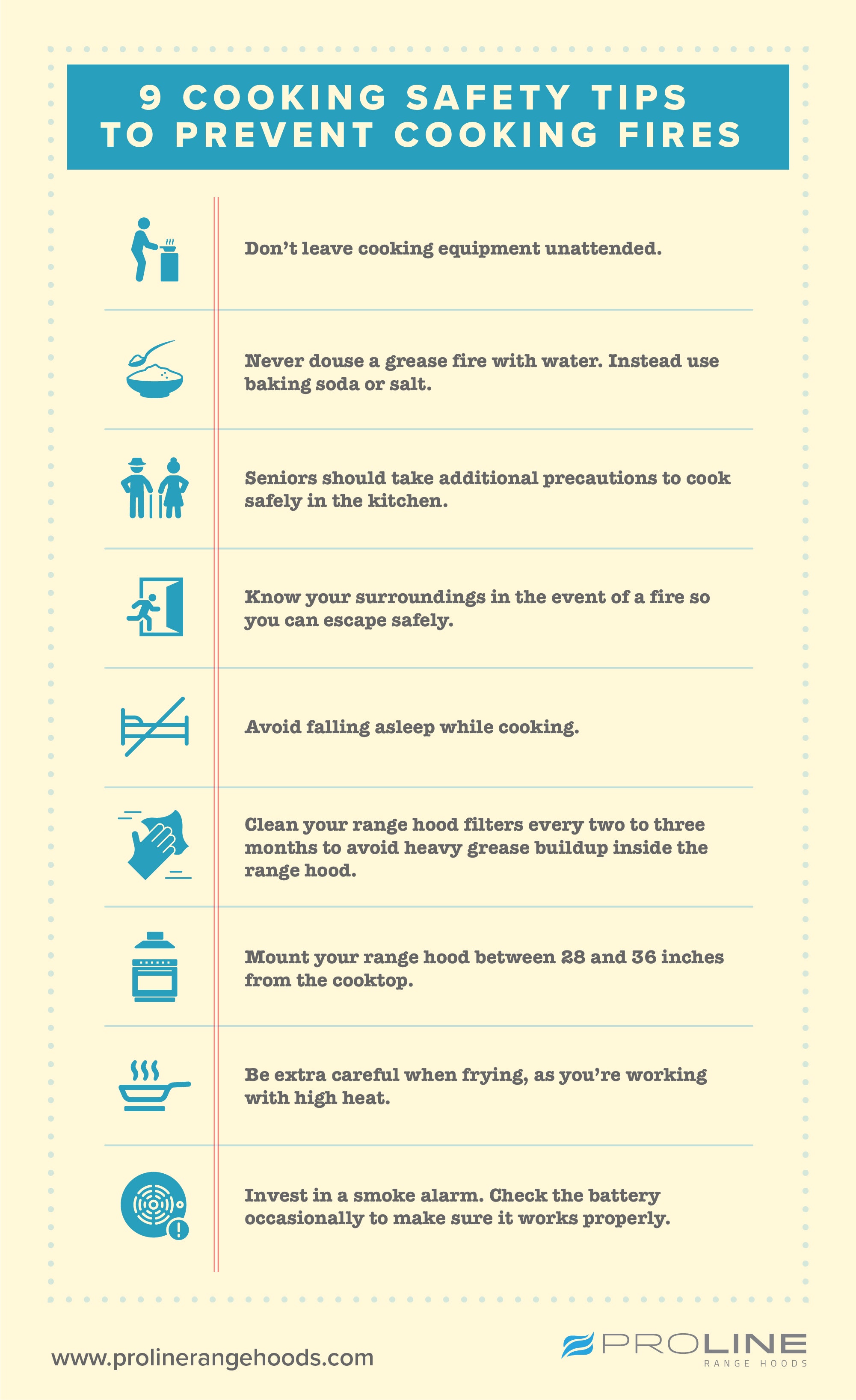
Don’t leave cooking equipment unattended.
Over half (53%) of deaths resulting from cooking fires are due to unattended cooking equipment. So, it’s important to take precautions when cooking.
Cooking fires can happen in seconds so avoid leaving food unsupervised. Simmering dishes at low heat is much safer but homeowners should be extra careful when cooking at high heat.
Never douse a grease fire with water. Instead use baking soda or salt.
Water can cause oil to splash and the fire to spread.
The rates of injury and death are higher for cooking fires involving cooking oil, lard, butter, and other fats. So, there needs to be more education around how to properly deal with grease fires and kitchen fires. Many of these fires are preventable with a fundamental knowledge of fire safety.
Seniors should take additional precautions to cook safely in the kitchen.
Cooking fires are more fatal for seniors. To stay safe while cooking, avoid multitasking. Cook with lightweight utensils and pans to reduce the risk of spills and burns.
Know your surroundings in the event of a fire so you can escape safely.
Learn where fire exits are and how to reduce smoke inhalation by covering your mouth with fabric or your shirt.
If you have a disability, you should make a concerted effort to learn fire safety. For starters, you’ll want a place that’s ADA compliant so they can get around easily. Have your fire extinguisher, baking soda, or other fire retardants handy.
Avoid falling asleep while cooking.
Falling asleep leads to 40% of cooking fire deaths. If you live alone, this can be particularly dangerous!
Clean your range hood filters every two to three months to avoid heavy grease buildup inside the range hood.
Heavy grease can cause fires which may lead to injury. Cleaning the inside of the hood every so often is a great idea as well.
Mount your range hood between 28 and 36 inches from the cooktop.
If you mount your hood closer than 28 inches, you risk starting a cooking fire and damaging your range hood. Mount outdoor hoods between 36 and 42 inches from the cooktop.
Be extra careful when frying, as you’re working with high heat.
Fires due to deep fryers are the most fatal, followed by ranges. Clean the filters on your range hood to reduce the risk of a grease fire.
Invest in a smoke alarm. Check the battery occasionally to make sure it works properly.
You’ll feel much safer with an operating smoke alarm in your home. In 30% of cooking fire deaths, the household had no smoke alarm. In addition, 17% of deaths involved smoke alarms that did not go off. Install it at least 10 feet away from the stove to reduce the risk of false alarms.
Hopefully, these cooking fire stats and safety tips helped inform you on how to stay safe in the kitchen. Take a look at the full infographic below. Thanks for reading.

Sources
NFPA Cooking Fires Statistics Report – 1980 – 2018
Home Cooking Fires Supporting Tables
The Downtown Decade: U.S. Population Density Rose in the 2010s – New York Times





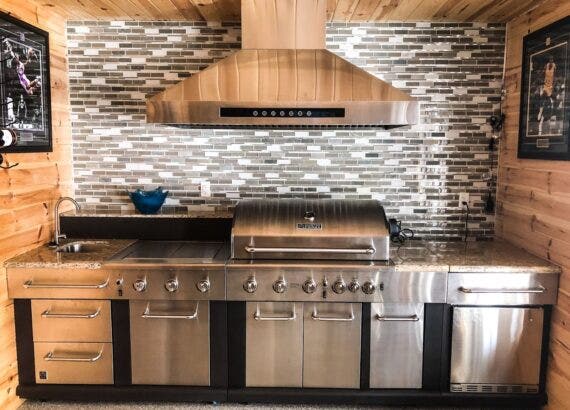
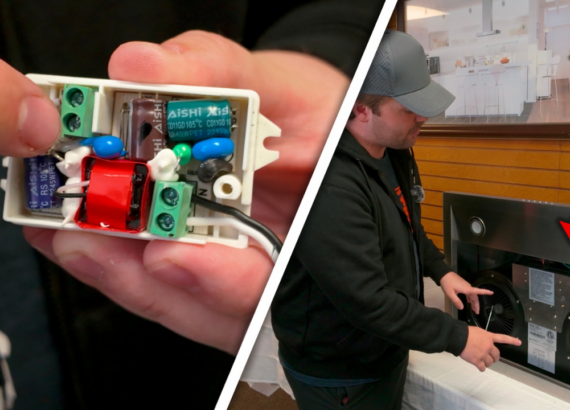
Comments are closed.